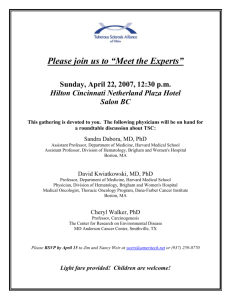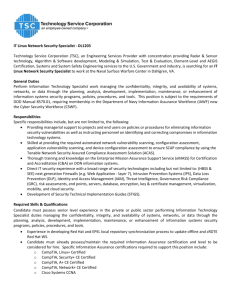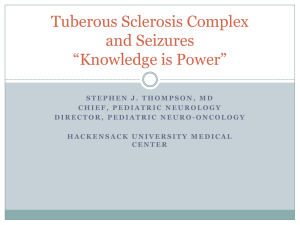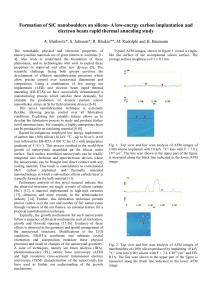Zero-bias thermally stimulated currents (ZB-TSC)
advertisement
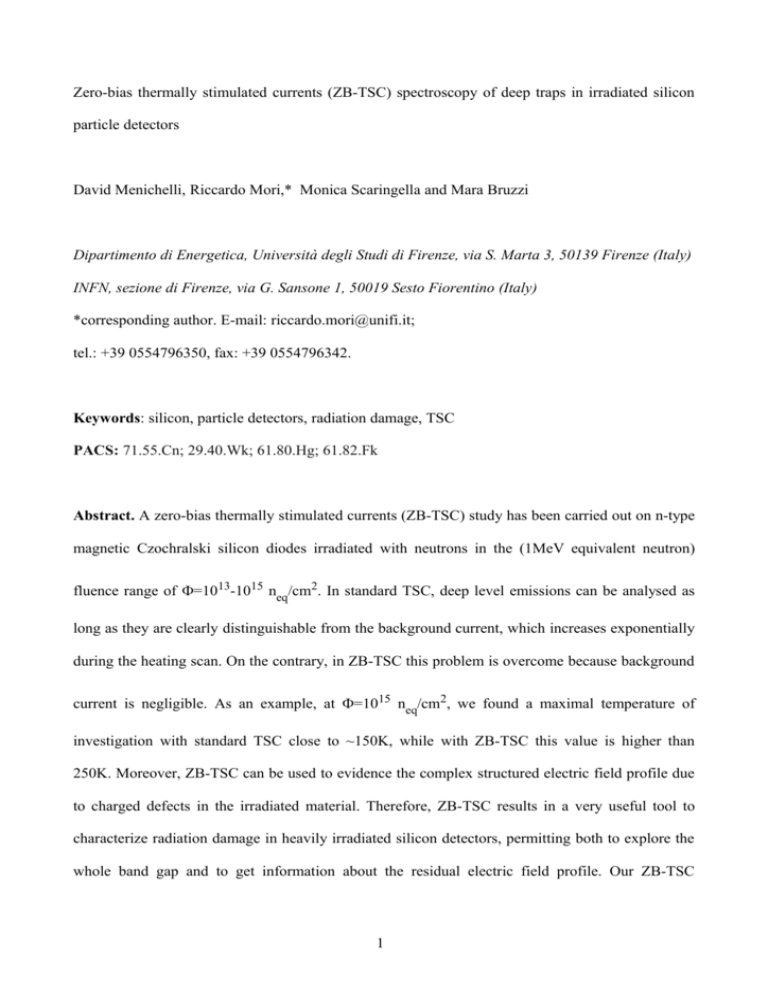
Zero-bias thermally stimulated currents (ZB-TSC) spectroscopy of deep traps in irradiated silicon particle detectors David Menichelli, Riccardo Mori,* Monica Scaringella and Mara Bruzzi Dipartimento di Energetica, Università degli Studi di Firenze, via S. Marta 3, 50139 Firenze (Italy) INFN, sezione di Firenze, via G. Sansone 1, 50019 Sesto Fiorentino (Italy) *corresponding author. E-mail: riccardo.mori@unifi.it; tel.: +39 0554796350, fax: +39 0554796342. Keywords: silicon, particle detectors, radiation damage, TSC PACS: 71.55.Cn; 29.40.Wk; 61.80.Hg; 61.82.Fk Abstract. A zero-bias thermally stimulated currents (ZB-TSC) study has been carried out on n-type magnetic Czochralski silicon diodes irradiated with neutrons in the (1MeV equivalent neutron) fluence range of Φ=1013-1015 neq/cm2. In standard TSC, deep level emissions can be analysed as long as they are clearly distinguishable from the background current, which increases exponentially during the heating scan. On the contrary, in ZB-TSC this problem is overcome because background current is negligible. As an example, at Φ=1015 neq/cm2, we found a maximal temperature of investigation with standard TSC close to ~150K, while with ZB-TSC this value is higher than 250K. Moreover, ZB-TSC can be used to evidence the complex structured electric field profile due to charged defects in the irradiated material. Therefore, ZB-TSC results in a very useful tool to characterize radiation damage in heavily irradiated silicon detectors, permitting both to explore the whole band gap and to get information about the residual electric field profile. Our ZB-TSC 1 measurements showed the presence of radiation-induced deep levels in the range 0.37-0.51eV, while no deeper levels were found. 2 1. Introduction Silicon is widely used as base-material for sensors in high energy physics experiments [1]. As the performances of silicon devices are strongly influenced by irradiation, a detailed study of the damage induced in such radiation environment is mandatory. Thermally Stimulated Currents (TSC) spectroscopy [2] is frequently adopted to study the radiation-induced lattice disorder, as this technique is effective even in presence of a large concentration of defects, when deep levels transient spectroscopy (DLTS) is not applicable. Nonetheless, the use of TSC is limited by the rise of the leakage current irev with the fluence Φ [1]: i rev ∝ , volume (1) i rev ∝T 2 exp− g / 2k B T , where εg is the energy gap and kB the Boltzmann constant. The higher the fluence of irradiation, the lower the maximal temperature at which the TSC signal becomes distinguishable from the background. For instance, as discussed later, this temperature limit is lower than 200K after a neutron fluence of 1014 neq/cm2 (throughout this paper, fluences will be given in terms of 1MeV equivalent neutrons). On the other hand, TSC emissions around and above 200K in hadron irradiated silicon are of particular interest, because they are believed to be related to extended defects originating from the clustering of primary vacancies. These deep levels can drive the electric field distribution inside the detectors, thus determining the onset of the double junction effect [3-6]. They are also candidates to explain the carrier trapping phenomena which limit the charge collection efficiency of silicon particle detector [7]. Detectors tolerant to hadron fluences up to 1016neq/cm2 are now under development [7] and conventional TSC does not permit to completely characterize the deep level population at this radiation level. In zero-bias TSC (ZB-TSC), no bias is applied to the sample during the thermal scan and the signal is driven by the built-in electric field. Thus, the background current is heavily suppressed [8] and a wider temperature range can be explored. In addition, the current sign gives information about 3 electric field distribution. This technique has been successfully used to study ion implanted semiinsulating GaAs [9] and, with an improvement aimed to account for sample temperature gradient, to high-dielectric-constant insulator films such as tantalum oxide [10]. The main drawback of ZBTSC is that it does not permit to determine the trap concentration N t due to the uncertainty in evaluating the active volume. Fig.1. Band diagrams and electric field profiles showing the basic mechanisms of carriers drift in ZB-TSC (left) and conventional TSC (right). Band bending at Ohmic contacts is not shown. The basic mechanisms of TSC and ZB-TSC signal generation are sketched in fig.1. We refer to a diode with initial p+/n/n+ structure, irradiated beyond the fluence threshold for double junction formation (1012-1013 neq/cm2, depending on the material kind) and heavily compensated by phosphorus removal. Voltages V are measured at n+ electrode with respect to p+, and currents are considered positive when flowing from n+ to p+. A hole trap (labeled X) and an electron trap (Y) are used in this example. In the figure, a qualitative description of band bending ε(x) and electric field profiles E(x) are given. Carriers injected during priming are trapped at energy levels, according to a distribution determined by the external polarization. During a TSC scan the sample is reversebiased (V>0) and the electric field has always the same direction (see fig.1 right). As a 4 consequence, electrons and holes, regardless of the bulk region from which they are emitted, produce a positive current. Differently, in ZB-TSC, after priming at low temperature, electrodes are short-circuited: carriers at electrodes and in bulk redistribute in order to establish zero voltage and zero field boundary conditions. Electric field changes sign inside the bulk (see fig.1, right), and a non-monotonous potential distribution with minima and maxima corresponding to zero electricfield planes settles. In this conditions, traps emitting close to p+ or n+ interfaces give rise to a positive current; those emitting in the bulk will produce a negative current. These two contributions, whose intensity is related to electric field rearrangement during emission [11,12], are summed up in the overall measured current. 2. Samples and experimental setup Our samples are p+/n/n+ planar diodes, with 0.5×0.5 cm2 active area, made on n-type magnetic Czochralski (MCz) produced by Okmetic (Finland) with 900 Ωcm resistivity, <100> orientation and 280µm thickness. Irradiation was performed with reactor neutrons at the Jozef Stefan Institute, Ljubljana up to 1.0×1013, 1.0×1014 and 1×1015 neq/cm2. Samples received about 1 year of annealing at room temperature after irradiation. Sample bias and current readout are provided by an electrometer (Keithley 6517A). Measurement resolution is 1×10-14A. Diodes are cooled in a dewar containing liquid nitrogen: a sample-holder is lowered into the dewar, and the depth of the sample-holder inside nitrogen vapors determines the initial temperature T0. Sample heating is provided by a wire-resistor wound inside the holder and the heating rate is β=0.10 K/s. 5 Fig.2. ZB-TSC spectra of three samples irradiated at different fluences. 3. Results and discussion ZB-TSC measurements performed at different fluences are shown in fig.2. Thick lines indicate measurements carried out in the following reference conditions: V=Vcool=100V during the cooling from room temperature to T0, V=Vfill=-100V to inject carriers at T0. At the lowest fluence a positive signal is observed in the range 130-160K. At the intermediate fluence the signal extends up to 190K and its zero-crossings reveal the presence of regions with opposite electric field. At the highest fluence the spectrum is completely dominated by negative components from the bulk. 6 Injection conditions strongly influence the spectrum shape, as shown in fig.2 by thin curves. This can be related to the facts that: i) the filling of deep levels substantially modifies the space charge distribution and, in turn, the electric field in the bulk. ii) Trap priming is not uniform, since holes are injected from p+ side and electrons from the n+ side. A tentative analysis of the levels signature has been performed in the most irradiated sample by a fractional heating technique, which includes the following stages: cooling at T 0 (under the bias V=Vcool); trap filling (V=Vfill); heating up to Tann (V=0); cooling again to T0 (V=0); heating up and measuring current (V=0). All the levels emitting below Tann are discharged before the measurement and a clear emission can be observed in the ZB-TSC signal around this temperature. We isolated in this way five deep levels, indicated as (a)-(d) in fig.3 Fig.3. Single level emissions isolated by fractional annealing (solid lines) and results of fit procedure (markers). Vfill=-100V. Neglecting space charge density variations, the current emitted from a single level with activation energy ε and cross section σ is [2]: 7 1T i (T ) ∝ N t ee / h exp − ∫ ee / h dT ' , . β To ee / h (T , ε , σ ) = γ e / hσ T 2 exp(− ε / k BT ). (2) Here ee/h(T,ε,σ) is the emission coefficient for electrons/holes, γe/h is a constant depending on the band structure of the material and kB is the Boltzmann's constant. Below peak temperature (T<<Tpeak) eq.(1) gives: ln(i ) ∝ 2 ln(T ) − ε k BT − 1 β ∫ T T0 ee / h (T ' )dT '. (3) In this region, current variations are dominated by the (ε /kBT) term, thus ε can be deduced by a linear fit of ln(i) plotted versus 1/T, as indicated in fig.3 . Using this ε value, a rough cross section estimate can be obtained by comparing the measurement with the prediction of eq.(1). Results are summarized in table 1. Henceforth we use a short notation, according to which, for instance, (0.37,1) means that ε=0.37eV and σ=1×10-15cm2. Emission (a) can be assigned to an electron trap (E4 at (0.37,10)) already measured by DLTS after hadron [13] and electron[14] irradiation. Emission (b) can be assigned to V2-/0 (see ref. 15). Emission (d) comes from a very deep trap with a signature similar to the level (0.52,1) observed [16] by DLTS in proton irradiated epitaxial silicon. This level could represent the edge of the band 0.47-0.49eV reported in ref.17. Emissions (a)-(e) can account for the broadness of the ZB-TSC spectrum, as shown in fig.4 (A). In this plot, single level contributions (dashed lines), calculated by eq. 2, have been scaled by an arbitrary factor in such a way that their sum (thin solid line) approximates the measured spectrum (thick solid line). No attempt to carry out a quantitative fit has been made, since the measured signal is distorted by the modulation of space charge density due to levels discharge. Contributions from other well known deep levels, such as CiOi [18], vacancy-phosphorous complex [19] and E5 at (0.45,3), could contribute to the measured spectrum, as well. 8 E5 is the level which, together with E4 has been recently assigned to I2O [20]. A continuous level distribution surrounding V2-/0, which could be related to vacancy clusters, has also been reported [17,21]. The peak positions of TSC signals from these levels have been indicated in fig.4 (A) as a reference. Label Settings Trap signature ε σ a b Tann Vcool (V) (K) 140 500 150 500 0.37 0.41 c d e 180 200 210 0.38 0.001-0.002 0.51 2-4 0.48 0.05-0.1 100 100 500 Type Origin (eV) (x10-15 cm2) 0.5-1 0.5-1 e e E4 V2 e/h e/h e/h TABLE 1. Experimental conditions and results of fractional annealing analysis. In fig.4 (B) two TSC spectra measured with a reverse bias V=100V are shown. Deep level emissions can be analyzed as long as they are distinguishable from the background current irev. If we take the amplitude imax of the peak close to 140K as the typical signal strength of a radiation induced deep level, and we estimate as the upper limit of temperature range T max the temperature at which iback=imax, we see that Tmax≈195K at Φ=1.0×1013neq/cm2 and Tmax≈185K at Φ=1.0×1014 neq/cm2. The situation becomes even worse at the highest investigated fluence (Tmax~150K). Instead (see fig.4 (A)), with ZB-TSC we have Tmax>250K. We conclude that with ZB-TSC the whole bandgap of silicon can be explored. As a matter of fact, even a level at midgap with a very small cross section, such as (0.56,0.01), would produce a peak at 235K, well within the explored range. It is thus unlikely that undetected levels deeper than (d) are present in our samples. 9 Fig.4. ZB-TSC (A) and TSC spectra (B) of the sample irradiated at Φ=1015neq/cm2, measured with Vfill=-100V. Fit with standard TSC curves using parameters from table I is shown. Peak position of the TSC signals which would be produced by levels in literature are indicated too. According to literature, other very deep levels could be produced and would generate a measurable signal within our available temperature range, as indicated in fig.4(A). Examples are the I-/0 defect at (0.58,0.7) and Γ at (0.68,50), measured by TSC in floating zone silicon after γ irradiation [20 22], which would produce peaks close to 190K and 220K, respectively. The CiOi related level at (0.71, 350) [18] found by DLTS after low energy proton irradiation would give Tpeak=220K. Two levels detected [23] by DLTS after He+ irradiation at (0.56,0.8) and (0.64,4) would generate signals peaked at 205K and 220K respectively. Nonetheless, these studies have been carried out by DLTS at low fluence, or by TSC after a cumbersome background signal subtraction. 1 The adoption of ZB-TSC in these cases would permit to extend the examined fluence range and to refine these results in low noise conditions. 4. Conclusions We carried out a zero-bias thermally stimulate currents (ZB-TSC) study on magnetic Czochralski silicon diodes irradiated with neutrons in the (1MeV equivalent neutron) fluence range of Φ=10131015 neq/cm2. These devices have been processed to investigate the effect of extreme hadron irradiation levels on silicon particle detectors. We proved that ZB-TSC is a technique suitable to investigate very deep levels in irradiated silicon, permitting to explore the full band gap. In particular, ZB-TSC is not influenced by the rise of background current irev, which represents the main factor limiting the application of thermal spectroscopy techniques (such as TSC, but also i-DLTS) to heavily irradiated devices. The presence of a strong intrinsic electric field due to the polarization of radiation-induced defects, combined with the electric field existing at electrodes due to double junction, give rise to current signals changing sign during the thermal scan. In particular, at Φ=1.0×1015neq/cm2 only negative currents are observed, whatever the injection conditions, indicating that emissions from traps within the bulk portion in between the double-junction regions at electrodes are dominating the current signal. Present measurements can be accounted for by deep levels identified in earlier observation, in conjunction with three levels at 0.38, 0.48 and 0.51eV. In particular, no levels deeper that 0.51eV have been found. Acknowledgments We wish to thank Eckhart Fretwurst and Gunnar Lindstroem at University of Hamburg for supplying us the samples, which were processed by CiS (Erfurt, Germany) in the framework of CiS-University Hamburg project (contract no. SSD 0517/03/05). Moreover, we are grateful to 1 Alessandra Giannini at University of Florence for her invaluable technical assistance. This work has been performed in the framework of the WODEAN project of the CERN RD50 Collaboration. 1 References [1] M. Bruzzi, IEEE Trans. Nucl. Sci., 48 (2001) 960. [2] H. Schade, D. Herrick, Solid State El., 12 (1969) 857. [3] Z. Li, H.W. Kraner, J. Electron. Mater. 21 (1992) 701. [4] V. Eremin, Z. Li, I. Iljashenko, Nucl. Instr. and Meth. A 360 (1995) 458. [5] E. Borchi, M. Bruzzi, Z. Li, S. Pirollo, Nucl. Instr. and Meth A 425 (1999) 343. [6] V. Chiochia et al., Nucl. Instr. and Meth. A 568 (2006) 51. [7] RD50 Status Report 2007, CERN-LHCC-2008-001 and LHCC-RD-015, Geneva, 2007. [8] D. K. Chen, M. B. Das, IEEE Trans. Electron Dev. 32 (1985) 2506. [9] W. S. Lau, T. C. Chong, L. S. Tan, C. H. Goo, K. S. Goh, and K. M. Lee, Appl. Phys. Lett. 61 (1992) 49. [10] W. S. Lau, K. F. Wong, T. Han and N. P. Sandler, Appl. Phys. Lett. 88 (2006) 172906. [11] J. Lindmayer, J. Appl. Phys. 36 (1965) 196. [12] B. Gross, M. M. Perlman, J. Appl. Phys. 43 (1972) 853. [13] M. Moll, E. Fretwurst, M. Kuhnke, G. Lindstroem, Nucl. Instr: and Meth. B 186 (2002) 100. [14] J. H. Bleka, E. V. Monakhov, B. G. Svensson, B. S. Avset, Phys. Rev. B, 76 (2007) 233204. [15] M. Moll, E. Fretwurst, M. Kuhnke, G. Lindstroem, Nucl. Instr. and Meth. A 388 (1997) 335. [16] D.C. Schmidt, J.F. Barbot, C. Blanchard, E. Ntsoenzok, Nucl. Instr. and Meth. B 132 (1997) 439. [17] D. Menichelli, S. Pirollo, Z. Li, IEEE Trans. Nucl. Sci., 47 (2000) 446. [18] A. Kahn et al, J. Appl. Phys. 87 (2000) 2162. [19] S. D. Brotherton, P. Bradley, J. Appl. Phys. 53 (1982) 5720. [20] J. H. Bleka, L. Murin, E. V. Monakhov, B. S. Avset, and B. G. Svensson, Appl. Phys. Lett. 92 (2008) 132102. 1 [21] I. Kovacevic, V.P. Markevich, I.. D. Hawkins, B. Pivac, A.R. Peaker, J. Phys.: Condens. Matter 17 (2005) S2229. [22] I. Pintilie, E. Fretwurst, G. Lindstroem, J. Stahl, Appl. Phys. Lett. 82 (2003) 2169. [23] D.C. Schmidt, J.F. Barbot, C. Blanchard, P. Desgardin, E. Ntsoenzok, G. Blondiaux, Appl. Phys. A 65 (1997) 403. 1

